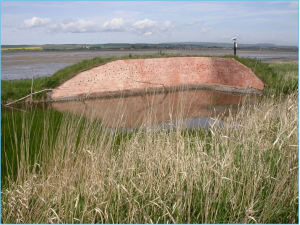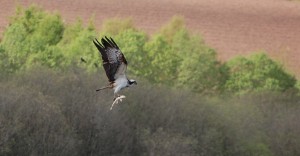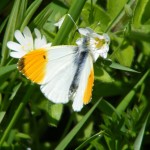Basin Notes

All around us, summer migrants have been appearing, with the first sand martin of the year recorded on Sunday 25th March, flitting around near the specially designed nesting wall at the Montrose Basin visitor Centre. All eyes are to the skies in anticipation of other migrating birds. We know that Ospreys have started to return to Scotland for the breeding season, with the famous female affectionately known as ‘Lady’ arriving on the nest at Loch of the Lowes on Friday 30th March for the 22nd consecutive year! On the same day, the first Osprey was seen at Montrose flying overhead with a fish clasped in its talons.
These impressive raptors have travelled some 3,000 miles from their wintering grounds in West Africa and will return to the same site for 5 months year after year to breed. The fastest recorded migration took just 31 days! After such an arduous journey, an Osprey’s first thoughts will be to restore their fat reserves and protect the nest from intruding birds looking for a breeding site.

Whilst in the UK, Ospreys exclusively eat fish, enabling them to coexist with other birds of prey, and the Basin offers an ideal fishing spot. It’s no wonder that Ospreys are such expert fish hunters. Their talons, razor sharp and curved, resemble a fish hook. The problem of slippery fish is overcome by tiny stipules covering the underside of an Osprey’s feet, acting a bit like Velcro, enabling them to grip their catch. That’s not all… one of their toes is also reversible, meaning they can turn fish around once they have retrieved them from the water, seemingly to make a more streamlined shape for carrying in flight. Another special feature that helps an Osprey catch fish is its incredibly good eyesight, making it possible to spot fish from a great height. Their eyes also have a semi-transparent third eyelid which protects their eyes when diving underwater.
Before diving for fish, an Osprey will hover at around 300 feet above the water to spot its prey. Once they have selected a fish, they will drop in closer, to around 50 feet, before plunging into a feet first dive, reaching astonishing speeds of up to 80 mph, often totally submersing themselves in the water. Amazingly, an Osprey is capable of carrying fish up to four times its own body weight, but will usually opt for smaller fish.
All of this skill is put to good use over the breeding season, with the male’s main role being to provide fish for the constantly hungry, growing chicks once they hatch from eggs after a 5-6 week incubation period. All of that protein means rapid growth and by the age of 7-8 weeks, the juveniles are ready to fledge and learn to fish for themselves.
So, keep your eyes peeled over the Basin for an osprey making this impressive dive for fish, over the coming months. At the height of the season, Ospreys are regularly seen several times a day!!

It’s not just the migrating birds that we need to be looking out for; our hibernating animals are now beginning to stir too. So, whilst you’re out, see if you can spot bees, hedgehogs, and bats, and when the sun is shining, keep eyes peeled for butterflies.
Anna Cheshier
Montrose Basin Ranger
Help protect Scotland’s wildlife
Our work to save Scotland’s wildlife is made possible thanks to the generosity of our members and supporters.
Join today from just £3 a month to help protect the species you love.
Preface
All around us, summer migrants have been appearing, with the first sand martin of the year recorded on Sunday 25th March, flitting around near the specially designed nesting wall at …
